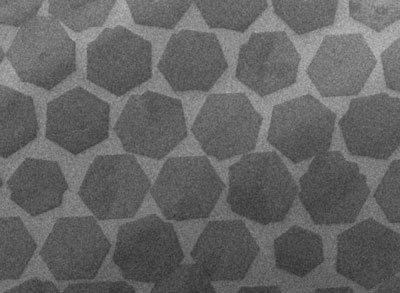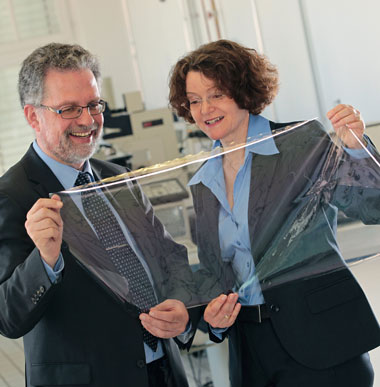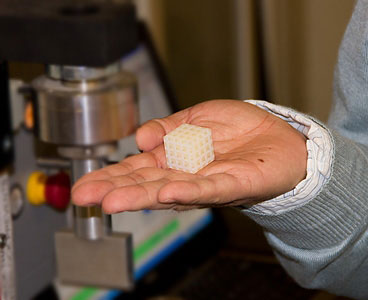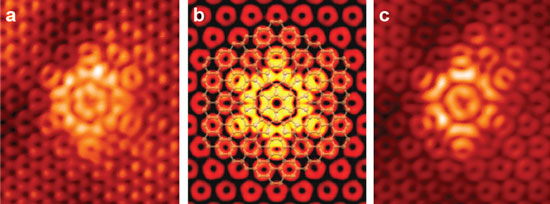 Researchers have developed a method for creating single-crystal arrays of graphene, an advance that opens up the possibility of a replacement for silicon in high-performance computers and electronics.
Researchers have developed a method for creating single-crystal arrays of graphene, an advance that opens up the possibility of a replacement for silicon in high-performance computers and electronics.
May 26th, 2011
Read more
 What do potato chips and thin-film solar cells have in common? Both need films that protect them from air and water vapor: the chips in order to stay fresh and crisp; the solar cells in order to have a useful life that is as long as possible.
What do potato chips and thin-film solar cells have in common? Both need films that protect them from air and water vapor: the chips in order to stay fresh and crisp; the solar cells in order to have a useful life that is as long as possible.
May 26th, 2011
Read more
In new work, a stamp replication process was developed and demonstrated for three different types of imprint molds. Replication relies on sequential patterning method called step and stamp nanoimprint lithography (SSIL).
May 26th, 2011
Read more
 New method of forming composites allows fine-tuning of mechanical, electrical, thermal and other properties.
New method of forming composites allows fine-tuning of mechanical, electrical, thermal and other properties.
May 26th, 2011
Read more
 Imec and its partners in the GaN industrial affiliation program (IIAP) have produced device-quality wafers with GaN/AlGaN layers on 200mm silicon wafers. With these wafers, functional GaN MISHEMTs were processed using standard CMOS tools.
Imec and its partners in the GaN industrial affiliation program (IIAP) have produced device-quality wafers with GaN/AlGaN layers on 200mm silicon wafers. With these wafers, functional GaN MISHEMTs were processed using standard CMOS tools.
May 26th, 2011
Read more
In a new study, researchers quantified for the first time these error-suppressing processes for model nanoelectronic systems and estimated the minimum number of electrons necessary for reliable circuit logic. They found that physical fault-tolerance in transistor circuits suppresses the error rate per electron exponentially, while even the most efficient architectural fault-tolerance system only suppresses the error rate subexponentially.
May 25th, 2011
Read more
Scientists at Imperial College London have made the most accurate measurement yet of the shape of the humble electron, finding that it is almost a perfect sphere. The experiment, which spanned more than a decade, suggests that the electron differs from being perfectly round by less than 0.000000000000000000000000001 cm. This means that if the electron was magnified to the size of the solar system, it would still appear spherical to within the width of a human hair.
May 25th, 2011
Read more
With every bodily movement - from the blink of an eye to running a marathon - nerve cells transmit signals to muscle cells. To do that, nerve cells rely on tiny molecular motors to transport chemical messengers (neurotransmitters) that excite muscles cells into action. It's a complex process, which scientists are still trying to understand. A new study by Syracuse University researchers has uncovered an important piece of the puzzle.
May 25th, 2011
Read more
Leading researchers from Harvard and MIT will present cutting-edge research being developed at both institutions.
May 25th, 2011
Read more
Thin-film solar cells without added silicon 'bulk' is the new creation of Czech and Swiss researchers and industry actors, who worked together to deliver a product that could deliver greater efficiency.
May 25th, 2011
Read more
Until only recently, MEMS devices have been viewed as distant cousins to computer chip technologies and consumer electronics, but with the rapid growth of mobile computing devices like smart phones and tablets, MEMS devices are becoming the indispensable 'eyes and ears' of information technology products.
May 25th, 2011
Read more
A wealth of information on recent advances in semiconductor research is now available for free, thanks to an agreement between the National Institute of Standards and Technology (NIST) and the American Institute of Physics (AIP).
May 25th, 2011
Read more
 A class of decorative, flower-like defects in the nanomaterial graphene could have potentially important effects on the material's already unique electrical and mechanical properties, according to researchers at the National Institute of Standards and Technology (NIST) and Georgia Tech.
A class of decorative, flower-like defects in the nanomaterial graphene could have potentially important effects on the material's already unique electrical and mechanical properties, according to researchers at the National Institute of Standards and Technology (NIST) and Georgia Tech.
May 25th, 2011
Read more
Research promises semiconductor manufacturing cost and production savings up to 15 percent, potentially increasing profit per chip significantly.
May 25th, 2011
Read more
Weizmann Institute scientists set a new record for measuring magnetic vibrations using the spin of a single atom: 100 times more accurate than the previous record.
May 25th, 2011
Read more
The Georgia Institute of Technology, in partnership with Northrop Grumman Corporation, has been selected to develop a new type of Microelectromechanical Systems (MEMS) gyroscope technology for the Defense Advanced Research Projects Agency (DARPA)'s Microscale Rate Integrating Gyroscope program.
May 25th, 2011
Read more
 Researchers have developed a method for creating single-crystal arrays of graphene, an advance that opens up the possibility of a replacement for silicon in high-performance computers and electronics.
Researchers have developed a method for creating single-crystal arrays of graphene, an advance that opens up the possibility of a replacement for silicon in high-performance computers and electronics. 




 Subscribe to our Nanotechnology News feed
Subscribe to our Nanotechnology News feed